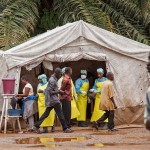
Working ahead of the curve
As the world scrambles to stop the further spread of Ebola, U of M infectious disease researchers face a different challenge: trying to anticipate what will strike next
When Gary Wong tells people he works in a Winnipeg research lab with a live Ebola virus, he never quite knows how they’ll react.
“It goes one of two ways: Some people think it’s really cool and some stay away from me,” Wong says.
The unassuming 31-year-old scientist is part of the University of Manitoba contingent who works with Canada’s National Microbiology Laboratory and found a treatment for people infected with Ebola. During the summer of 2014, with all eyes on the outbreak in West Africa, the group announced an even more effective cocktail of antibodies than their headline-grabbing mixture from two years earlier. They showed all of their lab’s monkeys could be saved up to five days after infection, even if they were already severely ill.

Gary Wong, a doctoral student, part of a team led by Gary Kobinger which performed the experiments to reverse advanced Ebola infection.
“It was very exciting, considering that for the longest time people have been saying that you can’t use antibodies to treat Ebola, that you need more than just antibodies. So it was very satisfying to show that, yes, they can be used,” says Wong, who grew up in Vancouver.
He did the research as part of his PhD, under medical microbiology associate professor Gary Kobinger.
“It was kind of like, ‘Wow, this works,’” says Wong. “We might have something significant on our hands. It kind of builds up and then you realize the implication of it all.”
Doses of the life-saving treatment, derived from the tobacco plant and dubbed ZMapp™, have since been shipped to hard-hit West Africa and used to help save infected patients returning to developed countries—including the first faces to make the news, American doctor and missionary Kent Brantly and nurse Nancy Writebol.
The vaccine to prevent Ebola infection is also a U of M discovery, dating back to 2005.
Eight hundred vials have been shipped overseas to help curb the outbreak, which has already killed 5,000 and infected more than twice that number. Kobinger and his group run a mobile diagnostic unit on the frontlines in Kailahun, Sierra Leone, testing patients’ blood. They’re among the few worldwide who know how to work safely with the virus. Back in the lab, they’re focused on finding ways of maximizing lives saved with a limited number of antibodies, which are expensive to produce. “It is difficult to produce a sufficient amount to combat the outbreak,” says Wong. “The supply hasn’t caught up with the demand yet. It takes a little bit of time because it’s still a very new technology.”
U of M infectious disease researchers first tackled Ebola more than a decade ago. They must work ahead of the curve, securing funding for potential threats most people have yet to hear about, says Keith Fowke, department head of medical microbiology.
“We don’t have a crystal ball so we don’t know what it’s going to be next,” he says. “One of the biggest challenges is that some of the pathogens that we’re trying to work with mutate so quickly that they are always evading the drugs we develop.”
Could Ebola, spread through contact with bodily fluids, become airborne? “It’s not impossible, but it’s not probable,” says Fowke.
The quickly mutating HIV has never gone airborne despite having been around for decades, he notes.
Wong and Fowke don’t anticipate Ebola becoming an epidemic in North America, but the outbreak serves as a bold reminder of the importance of having good medical systems worldwide.
What concerns Distinguished Professor Emeritus Allan Ronald, a pioneer in HIV/AIDS research, is that no one knows exactly how precaution-taking health care workers are becoming infected with Ebola. One of Ronald’s good friends—an American doctor in his 40s who he worked with in Uganda—contracted Ebola in Sierra Leone and is fighting the illness from an Atlanta hospital bed. “He was not someone who took unnecessary risks,” said Ronald in a phone interview from Cape Town, South Africa. “It’s terrible seeing your colleagues dying of something.”
The ongoing battle against HIV/AIDS
Colleagues credit Ronald with helping to create the discipline of infectious disease at the U of M and across Canada. He is on his 85th visit to Africa. His first was in 1979. Having dealt successfully with an outbreak of genital ulcers in Winnipeg, Ronald was asked by the University of Nairobi to help out with similar symptoms they were seeing in their patients.

Allan Ronald, a pioneer in HIV/AIDS research. Credited with helping to create the discipline of infectious diseases at the U of M and across Canada.
Ronald and his student, Frank Plummer—who would go on to become the scientific director general of the National Microbiology Lab—were among the first researchers to uncover HIV in Kenya in the early 1980s. In the beginning, there were so many unknowns. Ronald recalls an airline attendant, likely an AIDS victim, coming to the hospital with a horrible neck tumour blocking his trachea and within three days he was dead. “It was difficult because we didn’t know what caused it and there were all kinds of myths and hypotheses that weren’t true. People were afraid to provide care,” Ronald recalls.
Their studies were the beginning of an international collaboration that spans more than three decades and involves a growing number of researchers. The U of M-Nairobi partnership, which has received millions in funding from the Bill and Melinda Gates Foundation, has produced findings that changed the way the world thought about HIV, revealing it can be spread heterosexually and from mother to child through breastfeeding; and determining that sexually transmitted diseases like gonorrhea and chlamydia make it easier to be infected.
Research led by U of M professor Stephen Moses showed circumcision reduces men’s risk of infection by a whopping 60 per cent. This captured headlines—Time magazine heralded it as the most important medical breakthrough of the year in 2007—and helped kick start programs to expand male circumcision services throughout eastern and southern Africa. “It’s having a huge impact,” says Fowke.
In the late 1980s, Fowke was Plummer’s graduate student when the pair discovered that some Kenyan women, all of them sex workers, were naturally immune to HIV infection. Fast forward to 2014, and Fowke and his team have findings that suggest the women’s cells were in a resting state and that the virus prefers infecting highly active immune cells. They have used this insight to identify what could be the next major weapon in the war on HIV, found in an unlikely source: Hydroxychloroquine, an anti-malaria pill, and everyday Aspirin. Preliminary data, funded by Grand Challenges Canada and the Canadian Institutes of Health Research, shows the two anti-inflammatory drugs—both inexpensive and safe candidates for widespread use in developing countries—encourage a resting state, reducing the number of cells for the virus to target in the blood. Fowke wants to create a drug-delivering, internal vaginal ring which women would insert monthly to limit the number of target cells in their genital tract. “It’s a brand new prevention strategy,” Fowke says. “It’s something that people could do on their own, and that’s been proven safe and can be a brand new mechanism of trying to reduce the risk of HIV infections.”
“There will always be new micro-organisms, viruses, bacteria, fungi, parasites, so we’ve always got to be prepared for the unknown.”
Historically, prevention strategies developed in Kenya have been unrolled on an even larger scale in other parts of the world, including India and Pakistan. (Some of which are led by James Blanchard, the director of the university’s Centre for Global Public Health).
But there’s no one-size-fits-all solution, cautions Fowke. It’s vital that safe-sex messaging is modified to what works in a specific region and delivered by local experts. One way of educating locals is bringing them to the Bannaytne campus as medical microbiology PhD students. When they return, they’re better equipped to take on the plights of their countries and teach the generations that follow. “We’re really building up capacity,” Fowke says.
People are under the false impression that the HIV global pandemic is under control—it’s not. There are two million new infections annually, with 5,000 dying daily, he notes.
Predicting what’s coming next

Health workers screen people for the deadly Ebola virus in Sierra Leone. Photo by Michael Duff, Associated Press
Fowke first heard of the latest Ebola outbreak while tying up his skates for a game of shinny at a Winnipeg rink with some colleagues from the National Microbiology Lab. At the time, no one yet knew its true scale.
What other threats lurk below our radar? It’s hard to say when a virus could transfer from animal or insect to human at any given moment. (There is speculation that the first casualty of the latest Ebola outbreak—a two-year-old boy in Guinea—contracted the virus from a fruit bat.) Marburg hemorrhagic fever, a killer as ruthless as Ebola with two of its largest outbreaks in Germany and Serbia, has no vaccine or treatment available. Recently, two American backpackers contracted Marburg while backpacking in Uganda and brought it home to Colorado and the Netherlands. Wong suspects they caught it from an animal by doing something as simple a scraping themselves on a rock. Scientists are also monitoring the tropical, mosquito-born chikungunya virus that has reared its head in Africa, Asia, Europe, India and the United States, causing fever and severe joint pain. One of the newest and most worrisome viruses is D-68, a cold-like illness that has caused paralysis in some and killed more than a handful of people across North America.
Fowke admits science still doesn’t fully understand why the common flu sometimes kills perfectly healthy kids or adults. “We don’t know if it’s something unique about the virus or something unique about their immune system. I believe it’s a combination of the two.”
The only virus successfully eliminated to date is smallpox. Tuberculosis goes back to Egyptian times yet still runs rampant in First Nations communities in Manitoba. Polio still pops up in parts of Africa and there is even the occasional report of the flea-born plague, which wiped out one third of Europe and is now easily treated with antibiotics. A misuse of the latter will make our fight against illnesses going forward increasingly difficult, notes Ronald.
“There will always be new micro-organisms, viruses, bacteria, fungi, parasites,” he says. “So we’ve always got to be prepared for the unknown.”
Story originally appeared in the Winter 2015 issue of Research Life.
Research at the University of Manitoba is partially supported by funding from the Government of Canada Research Support Fund.







